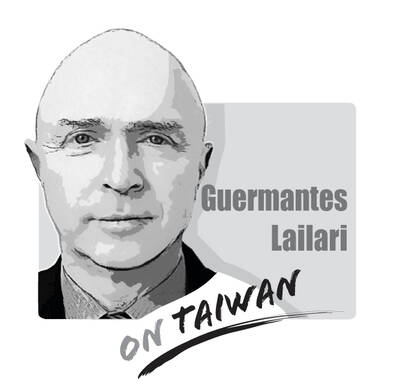When news of documentary filmmaker Chi Po-lin’s (齊柏林) unexpected passing in a helicopter crash broke last weekend, it is no exaggeration to say that the hearts of nearly everyone in Taiwan were saddened by the loss of a man who had literally risked life to capture the nation in all its glory.
However, as the nation mourned the acclaimed director, eyebrows were raised when the Chinese Nationalist Party (KMT) made an unprecedentedly poor decision by saying that Chi was “an outstanding KMT member.”
In addition to the blatant attempt to link the filmmaker’s name to the KMT, Central Policy Committee director Alex Tsai (蔡正元) even went so far as to post Chi’s party membership number on Facebook in an apparent bid to provide evidence that he was a member.
This is poor judgement, even for a party that has proved itself on countless occasions to be out of sync with mainstream values. The KMT should have known that there is a fine line between opportune political promotion and callous publicity stunts.
Equally apathetic are online discussions about Chi’s ethnicity. A discussion thread on Professional Technology Temple — the nation’s largest online academic bulletin board system — appeared shortly after Chi’s death. Netizens were eager to verify rumors of Chi being the descendant of a so-called waishengren (外省人), a term referring to people who fled to Taiwan with the KMT regime in 1949.
Some expressed their surprise that Chi, whose works had elevated him onto a pedestal as a staunch lover of Taiwan, could be the child of a waishengren.
The connotation of this astonishment is problematic and is at the root of Taiwan’s political polarization, as it suggests that only so-called benshengren (本省人) — literally “people from this province” — are capable of — or programmed to — “love Taiwan.”
Those who cling to this assumption are likely oblivious to the fact that a sizable proportion of the independence-leaning Democratic Progressive Party (DPP) are actually of waishengren backgrounds, as are some reputed academics who have been advocating for the nation’s interests.
The continued differentiation of waishengren from benshengren is not only sheerly discriminatory, but also poses a serious impediment to the formation of a unified Taiwanese nationalism in the face of growing Chinese suppression of the nation’s international space. It makes people who have grown up in Taiwan or identify with it as their home feel like outsiders.
Such differentiation might have its historical context, but it has become as pointless and politically incorrect as distinguishing Hakka from those of Hokkien ancestry. Whether one truly “loves Taiwan” should be determined by their words and deeds, rather than their race, ethnicity or even nationality.
Earlier this month, Taiwanese also mourned the death of Father Jerry Martinson, a US Jesuit missionary who lived and worked in Taiwan for 50 years and was best remembered for his dedication to education. Hardly anyone would question Martinson’s love for this nation of 23 million people.
In contrast, the KMT’s response to Beijing’s successful attempt to poach yet another of Taipei’s few diplomatic allies this week showed anything but the party’s concern for Taiwan and its national interests.
Instead of standing united behind the government in its lambasting of China’s pocketbook diplomacy, the KMT blamed Panama’s severance of diplomatic ties on what it called President Tsai Ing-wen’s (蔡英文) ideology-oriented handling of cross-strait relations.
The trend of politicizing issues that should transcend politics is unfortunate and could prevent people from evaluating issues solely on their merits.

Chinese state-owned companies COSCO Shipping Corporation and China Merchants have a 30 percent stake in Kaohsiung Port’s Kao Ming Container Terminal (Terminal No. 6) and COSCO leases Berths 65 and 66. It is extremely dangerous to allow Chinese companies or state-owned companies to operate critical infrastructure. Deterrence theorists are familiar with the concepts of deterrence “by punishment” and “by denial.” Deterrence by punishment threatens an aggressor with prohibitive costs (like retaliation or sanctions) that outweigh the benefits of their action, while deterrence by denial aims to make an attack so difficult that it becomes pointless. Elbridge Colby, currently serving as the Under
The Ministry of the Interior on Thursday last week said it ordered Internet service providers to block access to Chinese social media platform Xiaohongshu (小紅書, also known as RedNote in English) for a year, citing security risks and more than 1,700 alleged fraud cases on the platform since last year. The order took effect immediately, abruptly affecting more than 3 million users in Taiwan, and sparked discussions among politicians, online influencers and the public. The platform is often described as China’s version of Instagram or Pinterest, combining visual social media with e-commerce, and its users are predominantly young urban women,
Most Hong Kongers ignored the elections for its Legislative Council (LegCo) in 2021 and did so once again on Sunday. Unlike in 2021, moderate democrats who pledged their allegiance to Beijing were absent from the ballots this year. The electoral system overhaul is apparent revenge by Beijing for the democracy movement. On Sunday, the Hong Kong “patriots-only” election of the LegCo had a record-low turnout in the five geographical constituencies, with only 1.3 million people casting their ballots on the only seats that most Hong Kongers are eligible to vote for. Blank and invalid votes were up 50 percent from the previous
Japanese Prime Minister Sanae Takaichi lit a fuse the moment she declared that trouble for Taiwan means trouble for Japan. Beijing roared, Tokyo braced and like a plot twist nobody expected that early in the story, US President Donald Trump suddenly picked up the phone to talk to her. For a man who normally prefers to keep Asia guessing, the move itself was striking. What followed was even more intriguing. No one outside the room knows the exact phrasing, the tone or the diplomatic eyebrow raises exchanged, but the broad takeaway circulating among people familiar with the call was this: Trump did